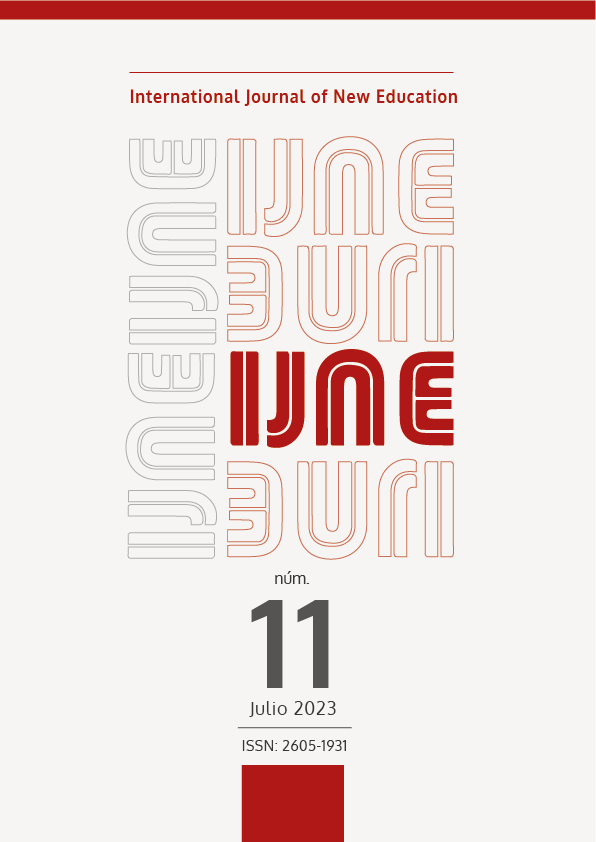The Impact of School Climate on Violence in Arab Schools in Jerusalem: The Perspective of Teachers
DOI:
https://doi.org/10.24310/IJNE.11.2023.16443Palabras clave:
violencia escolar, clima de aula, profesoradoResumen
La violencia escolar supone uno de los temas principales en la agenda de trabajo de Israel y en otros muchos países puesto que el número de alumnado implicado en estas situaciones es elevado considerablemente de acuerdo a estándares internacionales. El objetivo de este estudio es examinar las percepciones del profesorado del impacto del clima de aula para reducir la violencia en los centros árabes de Israel. Los instrumentos utilizados para la recogida de datos fueron un cuestionario y una entrevista semiestructurada. 352 profesores participaron en el estudio: 302 hicieron el cuestionario sobre el clima de aula y 50 realizaron la entrevista. Todos los participantes en el estudio pertenecen a la parte oriental de Jerusalén y trabajan en centros públicos y privados árabes. Los resultados del estudio indican que según la percepción el profesorado hay una relación positiva entre un clima de aula optimo y la reducción de la violencia en los centros árabes.
Descargas
Métricas
Publicación Facts
Perfil de revisores N/D
Información adicional autores
Indexado: {$indexList}
-
Indexado en
- Sociedad Académica/Grupo
- N/D
- Editora:
- Universidad de Málaga
Citas
Abu-Esba, H. (2007). Arab education in Israel: dilemmas of a national minority. Jerusalem: Florsheimer Institute for Policy Studies.
Abu-Saad, I. (2006). State-Controlled Education and Identity Formation Among the Palestinian Arab Minority in Israel. American Behavioral Scientist, 49(8), 1085-1100. https://doi.org/10.1177/0002764205284720
Ali, G. (2014). Violence and crime in Arab society in Israel: institutional conspiracy or cultural crime?
Bar-Lev, A. (2007). School climate: reality and vision. Beer-Sheva, Israel: The National Center for Further Education of Teaching Staff in the Fields of Spiritual and Social Judaism “Stable House”.
Bar-Maoz, T. (2008). Show me the website of your school and I will tell you about its organizational culture. Reviews of Education in Society in Technology and in science, 7, 20-24.
Benbenisti, R., Huri-Kasabri, M. & Astor, R. (2005). Violence in the educational system 2003: summarizing findings report. Jerusalem: Social Work Faculty, Hebrew University in Jerusalem
Cozma, I., Kukaswadia, A., Janssen, I., Craig, W., & Pickett, W. (2015). Active transportation and bullying in Canadian schoolchildren: a cross-sectional study. BMC Public Health, 15(1), 1-7.
HajYahia-Abu Ahmad, N. (2006). Zogiot ve horot ba meshpaha ha araviet ba Israel: Tahlekhi shenoi ve shimor ba shlosha dorot
Haj Yahya’, N., Seif, A., Kasir, N. & Paragon, K. (2021). Education and training in Arab society - gaps and buds of change.
Hannah, R. (2013). The effect of classroom environment on student learning.
Henry, S. (2000). What is school violence? An integrated definition. The annals of the American academy of political and social science, 567(1), 16-29.
Kuperminc, G. P., Leadbeater, B. J., & Blatt, S. J. (2001). School social climate and individual differences in vulnerability to psychopathology among middle school students. Journal of School psychology, 39(2), 141-159.
O’Brennan, L. M., Bradshaw, C. P., & Furlong, M. J. (2014). Influence of classroom and school climate on teacher perceptions of student problem behavior. School mental health, 6, 125-136.
Pellegrini, A. D., & Long, J. D. (2002). A longitudinal study of bullying, dominance, and victimization during the transition from primary school through secondary school. British journal of developmental psychology, 20(2), 259-280.
Reyes, M. R., Brackett, M. A., Rivers, S. E., White, M., & Salovey, P. (2012). Classroom emotional climate, student engagement, and academic achievement. Journal of educational psychology, 104(3), 700.
Ryan, R. M., & Deci, E. L. (2000). Self-determination theory and the facilitation of intrinsic motivation, social development, and well-being. American psychologist, 55(1), 68.
Sezer, Ş. (2021). Teacher-induced violence in the classroom and its effects on the development of students: A phenomenological analysis. Kuram ve Uygulamada Egitim Yönetimi Dergisi, 27(1), 945-966.
Shadmi, H. (2004). The counselor and promotion of optimality, in: R. Erhard & A. Klingman (Eds.), Education counseling in school in a changing society. Ramot publication, Tel-Aviv University, pp. 343-366
Sheaf, M. (2015). Improving classroom climate through a social intervention initiative.
Tzafroni, A. (2008). Organizational culture of the school: its characteristics and contribution to the effectiveness of the school. Studies in education in society in technology and science, 7, 3-8.
Publicado
Cómo citar
Número
Sección
Licencia
Las obras se publican en edición electrónica bajo una licencia Creative Commons Reconocimiento-NoComercial 4.0 España: se pueden copiar, usar, difundir, transmitir y exponer públicamente, siempre que:
a) Se cite la autoría y la fuente original de su publicación (revista,
editorial y URL de la obra.
b) No se usen para fines comerciales.
c) Se mencione la existencia y especificaciones de esta licencia de uso.
Será responsabilidad exclusiva de los autores obtener los permisos necesarios de las imágenes que estén sujetas a derechos de autor.









16.png)
